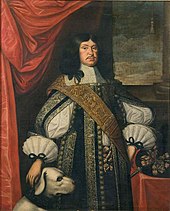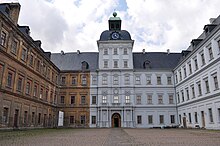August (Saxony-Weissenfels)

August von Sachsen-Weißenfels (born August 13, 1614 in Dresden , † June 4, 1680 in Halle ) was the first Duke of the Electoral Saxon secondary school of Saxony-Weißenfels and Prince of Saxony-Querfurt and the last administrator of the Magdeburg Archbishopric and founded a sideline of the Albertine Wettiner, the dukes of Saxony-Weissenfels.
family
Duke August was the second son of Elector Johann Georg I of Saxony , of his second wife Magdalena Sibylle of Prussia , a daughter of Margrave Albrecht Friedrich of Prussia . His siblings were the dukes Moritz von Sachsen-Zeitz and Christian von Sachsen-Merseburg , the elector Johann Georg II. Von Sachsen , the duchesses Maria Elisabeth , the wife of the duke Friedrich III. von Schleswig-Holstein-Gottorf and Magdalena Sibylle , the wife of Duke Friedrich Wilhelm II of Saxony-Altenburg .
Life
At the age of 13, Duke August was elected administrator on January 23, 1628 by the Magdeburg Cathedral Chapter to replace the previous administrator Christian Wilhelm von Brandenburg . At this point August had already been coadjutor there for three years . However, he was initially unable to take up his office as administrator, as the competitor Leopold Wilhelm of Austria , supported by the Pope and the Emperor , who was supposed to return the archbishopric to Catholicism , also received the title of archbishop after the conquest of Magdeburg in 1631. Leopold Wilhelm, however, in fact never exercised the office due to the Swedish occupation of the Archbishopric that followed immediately. During the Peace of Prague , Electoral Saxony was able to win back the Archbishopric for August. But it was not until the Swedish troops withdrew from his royal seat of Halle in 1638 that he was finally able to take office on October 18 of the same year. Secured by a neutrality agreement with Torstensson , Duke August was finally able to settle permanently in Halle on December 31, 1642. This was the beginning of a veritable upswing of the city into a courtly center.
Over time, David Elias Heidenreich , the Kapellmeister Philipp Stolle , David Pohle and Johann Philipp Krieger , the organist Christian Ritter and the writer Johann Beer worked at Duke August's court .
In 1643, Duke August was accepted into the Fruit Bringing Society by Prince Ludwig I of Anhalt-Köthen . He gave him the company name of the well-to-do and the motto in goodness virtuous . The Bibernell root was given to him as an emblem . His entry can be found in the Koethen Society Register under number 402. The rhyme law that he wrote on the occasion of his admission is also recorded there:
- The Wurzzel Bibernel in goodness virtuous
- The stone and water addiction are too well advised
- Drumb Wolgerahten I of such virtue
- I have been named: One should come to equip
- Common use wol: Yes, where virtue is
- Aldar take part in the highly desired deeds:
- The well-rounded fruit is validly presented,
- Because virtue excels in everything bare.
On July 15, 1667, the sons of Duke Wilhelm IV of Saxe-Weimar proposed the presidency of the Fruit Bringing Society to Duke August five years after his death . He accepted this office although he was neither an artist nor a scientist. As an art-loving patron, however, he encouraged the maintenance of music and theater at his court. Under his leadership, the Fruitful Society changed more and more to a court order with purely representative tasks. Through his love of splendor and waste, he laid the foundation for the deep indebtedness of his descendants.
By fulfilling his father's testament from 1652 and making inheritance comparisons with his brothers, Duke August was able to secure and enlarge his domain within the Saxon hereditary lands. The comparison of April 22, 1657 and the gain in the Barby rule , which he later left to his son Heinrich and his heirs, as well as the area around Querfurt should be mentioned.
On July 25, 1660, the foundation stone was laid for August's Neu-Augustusburg Castle in Weißenfels . This happened on the castle hill at the point where the castle, which had been devastated by the Swedes, had been. With the end of the war and the associated Peace of Westphalia in 1648 , the Electorate of Brandenburg acquired the claim to the secular property of the Archdiocese, the Archbishopric Magdeburg as the future Duchy of Magdeburg , which also included the city of Halle, where August lived in the New Residence . The claim should be claimed as soon as August, the last administrator of the Archdiocese of Magdeburg, died. It is therefore assumed that Duke August had the Weissenfels Castle Neu-Augustusburg built for his son Johann Adolf I , as this would be limited to the secondary education of the Duchy of Saxony-Weissenfels .
August von Sachsen-Weißenfels died on June 4, 1680 in Halle at the age of 65.
Marriage and offspring
His first marriage was on November 23, 1647 in Schwerin with Anna Maria von Mecklenburg-Schwerin , the daughter of Duke Adolf Friedrich I of Mecklenburg-Schwerin from his first marriage to Anna Maria von Ostfriesland , daughter of Count Enno III. from East Frisia .
He had the following children with his first wife:
- Magdalena Sybille (1648–1681), Princess of Saxe-Weissenfels ⚭ Friedrich I, Duke of Saxe-Gotha-Altenburg
- Johann Adolf I (1649–1697), Duke of Saxe-Weissenfels-Querfurt ⚭ (I) Johanna Magdalena von Sachsen-Altenburg and ⚭ (II) Christina Wilhelmina von Bünau
- August (1650–1674), Prince of Saxony-Weißenfels and Provost of Magdeburg ⚭ Charlotte of Hessen-Eschwege
- Christian (1652–1689), Prince of Saxony-Weißenfels and Field Marshal General of the Electoral Saxon Army
- Anne Marie (born February 28, 1653 in Halle; † February 17, 1671 ibid), Princess of Saxony-Weissenfels
- Sophia (1654–1724), Princess of Saxony-Weißenfels ⚭ Karl Wilhelm, Prince of Anhalt-Zerbst
- Katharina (born September 12, 1655 in Halle; † April 21, 1663 ibid), Princess of Saxony-Weißenfels
- Christine (born August 25, 1656 in Halle, † April 27, 1698 in Eutin), Princess of Saxony-Weißenfels ⚭ August Friedrich, Prince of Holstein-Gottorf and Prince-Bishop of Lübeck
- Heinrich (1657–1728), Duke of Sachsen-Weißenfels-Barby ⚭ Elisabeth Albertine of Anhalt-Dessau
- Albrecht (1659–1692), Prince of Saxony-Weißenfels ⚭ Christiana Theresia von Löwenstein-Wertheim-Rochefort
- Elisabeth (born August 25, 1660 in Halle; † May 11, 1663 ibid), Princess of Saxony-Weißenfels
- Dorothea (* December 17, 1662 in Halle; † May 12, 1663 ibid), Princess of Saxony-Weissenfels
After the death of his first wife on December 11, 1669, he married a second time on January 29, 1672 zu Halle Johanna Walpurgis von Leiningen-Westerburg , the daughter of Georg Wilhelm, Count von Leiningen-Westerburg from his marriage to Sophie Elisabeth zur Lippe-Detmold .
He had the following children with his second wife:
- Friedrich (1673–1715), Duke of Saxony-Weißenfels-Dahme ⚭ Emilie Agnes Reuss zu Schleiz
- Moritz (born January 5, 1676 in Halle, † September 12, 1695 in Szeged), Prince of Saxony-Weissenfels
- stillborn son (* / † 1679)
ancestors
| Pedigree of August von Sachsen-Weißenfels | ||||||||
|---|---|---|---|---|---|---|---|---|
| Great-great-grandparents |
Duke |
King |
Elector |
Duke |
Margrave |
Prince |
Duke |
Emperor |
| Great grandparents |
Elector August of Saxony (1526–1586) |
Elector Johann Georg von Brandenburg (1525–1598) |
Duke Albrecht of Prussia (1490–1568) |
Duke Wilhelm V (1516–1592) |
||||
| Grandparents |
Elector Christian I of Saxony (1560–1591) |
Duke Albrecht Friedrich of Prussia (1553–1618) |
||||||
| parents |
Elector Johann Georg I of Saxony (1585–1656) |
|||||||
|
August von Sachsen-Weißenfels |
||||||||
literature
- Johann Christoph von Dreyhaupt : Description of the… Saal-Creyses, especially the cities of Halle ; Hall 1749/1751 ( Dreyhaupt Chronicle )
- Heinrich Theodor Flathe : August (Duke of Saxony-Weissenfels) . In: Allgemeine Deutsche Biographie (ADB). Volume 1, Duncker & Humblot, Leipzig 1875, p. 680 f.
- Klaus Gondermann: The members of the fruitful society 1617–1650: 527 biographies. Leipzig, 1985.
- Johann Huebners: Three hundred and three and thirty genealogical tables ; Tab. 169
- Boje E. Schmuhl (Ed.) In connection with Thomas Bauer-Friedrich : In the land of the palm. August of Saxony (1614–1680), Archbishop of Magdeburg and Prince in Halle. Moritzburg Art Museum, Halle (Saale) 2014 (Writings of the Moritzburg Art Museum Halle (Saale), Volume 2); ISBN 978-3-86105-080-3 .
- Hellmut Kretzschmar: August. In: New German Biography (NDB). Volume 1, Duncker & Humblot, Berlin 1953, ISBN 3-428-00182-6 , p. 450 ( digitized version ).
- Dirk Schleinert : Anna Maria von Mecklenburg (1627–1669) and August von Sachsen (1614–1680) and the establishment of the House of Saxony-Weissenfels. Dynastic relations between Mecklenburg and Electoral Saxony in the 17th century , in: Mecklenburgische Jahrbücher 123. Jg. (2008), pp. 123–157.
- 300 years of Neu-Augustusburg Castle, 1660–1694 - residence of the Dukes of Saxony-Weissenfels. Festschrift . Weißenfels 1994.
- Andrea Thiele : residence on call? Court and town society in Halle (Saale) under the last administrator of the Archbishopric of Magdeburg, August von Sachsen (1614-1680) . Halle (Saale) 2011 (= research on the history of the city of Halle; 16).
- Andrea Thiele: Four decades in Halle - the city on the Saale as the residence of August of Saxony, postulated administrator of the ore monastery of Magdeburg (1614–1680). in: Baroque princely residences on the Saale, Unstrut and Elster. Pp. 122-132; Michael Imhof Verlag, Petersberg 2007; ISBN 978-3-86568-218-5 .
- Joachim Säckl / Andrea Thiele: August of Saxony, administrator of the Archbishopric of Magdeburg, Duke of Saxony-Weißenfels (born August 13, 1614 in Dresden, + June 4, 1680 in Halle / Saale) . In: Mitteldeutsches Jahrbuch für Kultur und Geschichte, Vol. 21 (2014), pp. 272–275.
Web links
- Works by and about August in the German Digital Library
- Publications from and about August in VD 17 .
- History of the five dukes of Weißenfels
- In the land of the palm
- Tripota - Trier portrait database
| predecessor | Office | successor |
|---|---|---|
| Leopold Wilhelm of Austria |
Postulated administrator of the Archbishopric of Magdeburg 1638–1680 |
Friedrich Wilhelm , Elector of Brandenburg |
| from the Electorate of Saxony emerged |
Duke of Saxony-Weißenfels 1656 / 57–1680 |
Johann Adolf I. |
| August Ludwig |
Earl of Barby 1659–1680 |
Heinrich |
| emerged from the Electorate of Saxony and the Archbishopric of Magdeburg |
Prince of Saxony-Querfurt 1663–1680 |
Johann Adolf I. |
| personal data | |
|---|---|
| SURNAME | August |
| ALTERNATIVE NAMES | August von Sachsen-Weißenfels; August the Elder; August von Wettin; August II of Wettin |
| BRIEF DESCRIPTION | Duke of Saxe-Weissenfels, Prince of Saxe-Querfurt, Administrator of Magdeburg |
| DATE OF BIRTH | August 13, 1614 |
| PLACE OF BIRTH | Dresden |
| DATE OF DEATH | June 4, 1680 |
| Place of death | Halle (Saale) |



